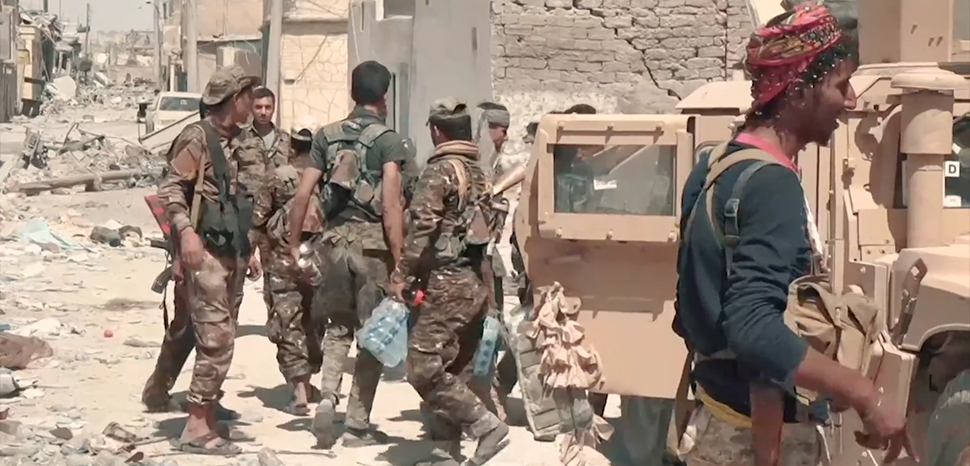While the US-led coalition’s breakup of the Islamic State’s proto-state – or “caliphate” – in 2019 was a significant victory, it failed to fully defeat the extremist group or remove the socioeconomic conditions that were conducive to the organization’s initial expansion. For the last three years, ISIS – The Islamic State in Iraq and Syria – has demonstrated considerable resilience against persistent coalition efforts at its eradication and has been slowly adapting, consolidating, and creating an environment favorable to its potential resurgence in central and northeastern Syria. Although defeated militarily, ISIS still has large numbers of fighters that it can call upon in the Syrian Arab Republic and has been waging a low-level insurgency against a multitude of actors, designed to showcase capability, undermine public confidence in local authorities, and to prevent reconciliation and stabilization efforts in cross-sectarian areas. The Islamic State aspires to regain its lost territory and influence following the collapse of its caliphate by exploiting the fragility of Syrian state structures.
Similar to its initial expansion in 2014, the Syrian quagmire has again presented ISIS with the opportunity to bolster its fighting capacity. A multitude of parties now control the land that once made up the group’s domain: the Kurdish-led Syrian Democratic Forces (SDF), backed by a US-led global coalition aimed at defeating ISIS in northeastern Syria; Turkey and its Syrian allies in the northern Aleppo governate, the Islamist group Hayat Tahir al sham in the Idlib governate; and the Assad regime with support from its Russian and Iranian allies in the central Syrian desert. These actors, who are consistently in conflict with one another, often fail to coordinate anti-ISIS operations and interoperability among them is essentially nonexistent. Failure to prevent the movement of Islamic State fighters across permeable lines of control has allowed the group to treat Syria’s provinces as interconnected theaters, giving it the operational space needed to wage a prolonged insurgency and flexibility in its strategy for reasserting territorial control in the future.
ISIS uses the territory controlled by these actors to carve out zones of influence. The group uses the central Syrian desert as a base of operations and this is where it trains its recruits; in the northeast, ISIS gathers funds and supplies, as it simultaneously attacks security forces, tribal leaders, and other individuals of importance to erode public confidence in local governance; and in the north and northwest it maintains hideouts for its mid- to high-level commanders who are difficult to distinguish from the thousands of internally displaced Syrians living in makeshift settlements. Particularly, the insurgencies in central and northeastern Syria are more intertwined as the group moves its fighters and materials between regime- and SDF-controlled territory depending on its objectives, logistical needs, and its foe’s vulnerabilities in each area. Indeed, central and northeastern Syria have experienced the most significant ISIS activity.
The Central Syrian desert has become a staging area for ISIS operations, as it is a vast, rocky, and desolate expanse that encompasses significant portions of many of Syria’s governates. The Islamic State uses the desert to store weapons and supplies and has set up training camps and safehouses that its fighters and commanders retreat to when they come under significant pressure from other fronts. Due to the sheer size of the desert and its topography, anti-ISIS operations by Damascus and its allies have failed to meaningfully disrupt the Islamic State’s operations. Complicating matters further, Islamic state cells now operate in a highly decentralized structure, where regional and local commanders are imbued with wide-ranging authority, ensuring the survival of the organization should senior level leaders be eliminated. ISIS has adapted its strategy and ensures that cells operating in central Syria are spread throughout the region and rely on a small unit structure to survive, making militants difficult to track and eliminate.
The Islamic State’s ability to wage an insurgency in northeastern Syria is bolstered by the incompetence of the SDF, which has failed to include local Arabs in decision-making processes; thus the group fails to provide adequate security, inadvertently causes harm to locals during anti-terror operations via wrongful arrests, and fails to offset economic hardship. Together, these factors have created an opening that ISIS has exploited to undermine civilian trust in Kurdish leadership and elevate the organization’s appeal.
There is growing sentiment amongst the local population in northeastern Syria that the SDF is unable to provide sufficient security and its ability to operate effectively is dependent upon U.S. support. These perceptions are exacerbated when the U.S. long term commitment to the SDF is in question, as Washington’s hasty withdrawal from Afghanistan has cultivated a fear of abandonment. This precarious security/support situation discourages the population from cooperating on counter ISIS raids, as the Islamic State is known to assassinate known informants, and locals believe their protection is not guaranteed.
Another threat to the SDF’s ability to counter ISIS is its ongoing conflict with neighboring Turkey. Intermittent clashes along the Syrian-Turkish border since Ankara’s most recent incursion into Syria in 2019 diverts SDF resources away from ISIS and relieves pressure on the organization. In May 2022, Turkish President Erdogan threatened a renewed offensive against the SDF, causing more intelligence assets to be diverted away from Islamic State cells and toward the more conventional threat. Furthermore, the group utilizes networks of autonomous cells answering to commanders based elsewhere – even outside Syria – making their elimination extremely difficult. Learning from previous experiences, the Islamic State adjusts its tactics to meet the varying degrees of SDF control from place to place and meets with considerable success. Perhaps most dramatically, it undermines the SDF with jailbreaks, the largest of which occurred in January at Ghowayran prison in Hasakeh. Such attacks undermine public confidence in local authorities and release battle-hardened militants.
The porous lines of control separating various parts of Syria make it difficult for security forces to degrade the insurgency in the northeast – and the fact that commanders live elsewhere makes it even more difficult. ISIS units can escape pressure in one area by moving elsewhere. Plus, most counter-ISIS operations round up only low-level insurgents, who can be replaced by new fighters recruited in the northeast and trained in central Syria. Meanwhile, security forces struggle even to identify Islamic State commanders, let alone arrest them, due in large part to the difficulties the SDF and US-led coalition face in building effective intelligence networks.
ISIS has ensured that despite the loss of its territory and physical financial holdings, the organization will receive revenue that allows it to achieve its goals. Since its inception, the Islamic State has maintained a consistent financial strategy that aims to support the group’s goals of state-building and Sharia law implementation. Its financial doctrine is highlighted by two important facets: striving for financial self sufficiency and derivation of its economic governance from Islamic principles. Interestingly, despite rigid adherence to traditional Islamic law, ISIS’ financial strategy allows for significant adaptability and resilience to evolving circumstances, changing battlefield environments, and economic shocks, which often deviates from basic Islamic principles but ensures the survivability of the organization and its goals. Military pressure and seizure of its territorial holdings has had a significant impact on the group’s ability to raise revenue in Syria as of 2019. However, the group is adapting to its new underground insurgency role with fewer demands on its financial holdings and relies on more traditional criminal activity to maintain its revenue streams; examples include smuggling, extortion, stealing and kidnapping for ransom. The collapse of the Syrian economy and depreciation of the Syrian pound has additionally placed importance on the facilitation of criminal and informal economic activity as more conventional methods of trade are less profitable.
One of the benefits of having administered governance to a significant populace, is that the Islamic State has collected records on thousands of individuals. It is likely that the Islamic state is in possession of vast amounts of information on local Syrians and currently utilizes it to the group’s benefit. While in possession of such information, the organization is given even more of an ability to engage in criminal activities such as extortion and kidnapping across small and large population centers in Syria.
Since the loss of its caliphate, there has been a remarkable decline in the Islamic State’s expenditures, often overlooked by those more concerned about what the group is earning. By losing territory, ISIS has reduced governance costs, and its reconstitution as a clandestine insurgency has reduced military costs. Loss of fighters and members due to combat allows the group more flexibility in the management of salaries and has concurrently reduced personal costs. The Islamic State’s reduced expenses and current economic practices enable the organization to sustain itself, rebuild its foundations, and perniciously achieve its objectives. ISIS consistently demonstrates its organizational resilience by preserving financial structures and retaining the capacity to raise and move money.
It is evident that ISIS has taken advantage of the conflict, chaos, and institutional weakness within Syria to expand its operational presence. While unlikely that ISIS will ever regain its territorial caliphate or reach a level of prestige as it did in 2015, its growing presence undermines stability in the Middle East. To gradually defeat the Islamic State, adversaries will have to put their differences aside and engage in intelligence cooperation to ensure the group’s fighters cannot easily cross lines of control. The US-led War on Terror has demonstrated that sustained military action alone does not counter insurgencies effectively. To prevent the potential resurgence of ISIS and to wither away the group’s appeal, the economic situation in Syria must be improved, political reconciliation between warring parties and sectarian groups must be achieved, and the quality of public services must remain constant and sufficient. However, such goals will be difficult to materialize and will take years of investment, reform, and relative stability achieve. Given the current situation unfolding within Syria, it is unlikely anything meaningful will be achieved in the immediate future.




